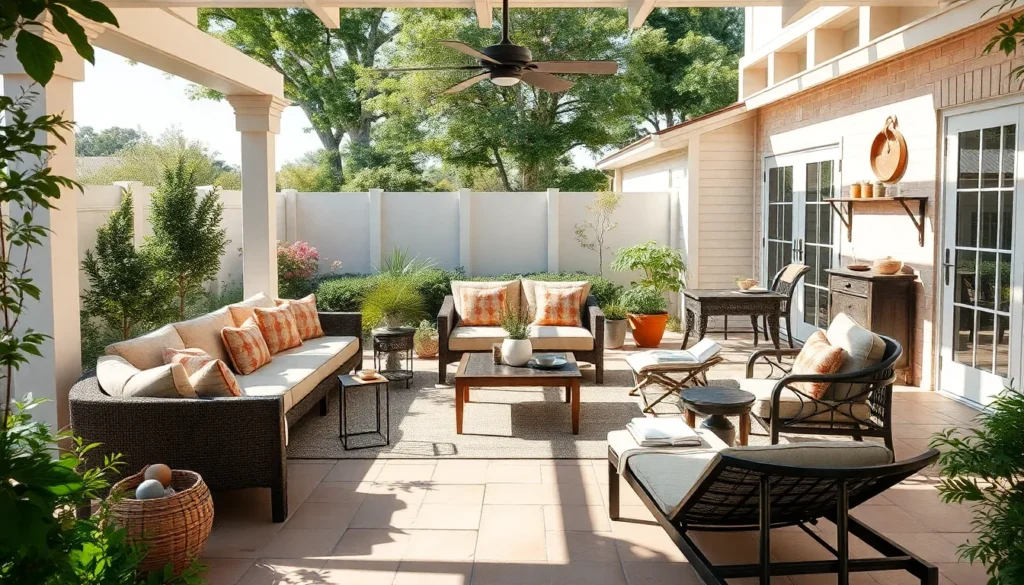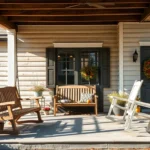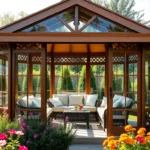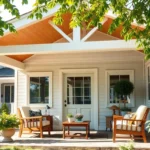We’ve all been there – staring at an empty patio wondering how to transform it into the perfect outdoor sanctuary. The right furniture layout can make or break your outdoor space, turning a bland deck into an inviting retreat where you’ll actually want to spend time.
Creating the ideal patio arrangement isn’t just about cramming furniture onto your deck. It’s about maximizing your space while ensuring smooth traffic flow and creating distinct zones for different activities. Whether you’re working with a compact balcony or sprawling outdoor area, strategic placement makes all the difference.
The best part? You don’t need an interior design degree to nail your patio layout. With a few proven strategies and creative ideas, we’ll show you how to arrange your outdoor furniture like a pro and create the backyard oasis you’ve been dreaming of.
Create a Cozy Conversation Area with Strategic Seating Arrangements
Building on our foundation of effective patio zones, we’ll now focus on crafting intimate spaces where meaningful connections happen naturally. Strategic seating arrangements transform ordinary outdoor furniture into welcoming conversation hubs that encourage guests to linger and connect.
Position Chairs and Sofas in a U-Shape Formation
U-shaped seating arrangements create the most inviting conversation spaces by naturally drawing people together while maintaining comfortable personal boundaries. We recommend positioning your largest piece like a sectional sofa as the base of the U, then flanking it with matching armchairs or smaller sofas on each side.
Place seating pieces 6 to 8 feet apart to ensure everyone can hear each other without shouting while still having enough room to move around comfortably. This distance allows for easy conversation flow while preventing the cramped feeling that comes with furniture placed too close together.
Angle chairs slightly inward toward the center of the conversation area rather than placing them in perfectly straight lines. This subtle positioning trick makes the space feel more intimate and encourages natural eye contact between guests sitting in different areas of the U formation.
Add a Central Coffee Table for Functionality
Coffee tables serve as the anchor point for any successful conversation area by providing a shared surface that brings the seating arrangement together visually and functionally. We suggest choosing a table that’s approximately two-thirds the length of your longest seating piece to maintain proper proportions.
Keep the table height between 16 to 18 inches to ensure it’s accessible from all seating positions without blocking sightlines across the conversation area. Round or oval tables work exceptionally well in U-shaped arrangements because they eliminate sharp corners that might impede traffic flow.
Select weather-resistant materials like teak, aluminum, or all-weather wicker that can withstand outdoor elements while complementing your existing patio furniture style. These materials maintain their appearance season after season with minimal maintenance requirements.
Include Side Tables for Drinks and Accessories
Side tables eliminate the need for guests to reach across the conversation area for their drinks, snacks, or personal items, making the space more comfortable and functional for extended gatherings. We recommend placing one side table within arm’s reach of every two seating positions.
Choose tables that stand 20 to 24 inches tall to align properly with standard chair and sofa arm heights, creating a seamless surface for placing items without awkward reaching or stretching. This height range works well with most outdoor furniture dimensions.
Coordinate side table styles with your central coffee table while allowing for slight variations in size or finish to add visual interest without creating chaos. Matching families of tables create cohesion while different sizes provide flexibility for various items like books, plants, or decorative accessories.
Design a Dining Zone for Outdoor Entertaining
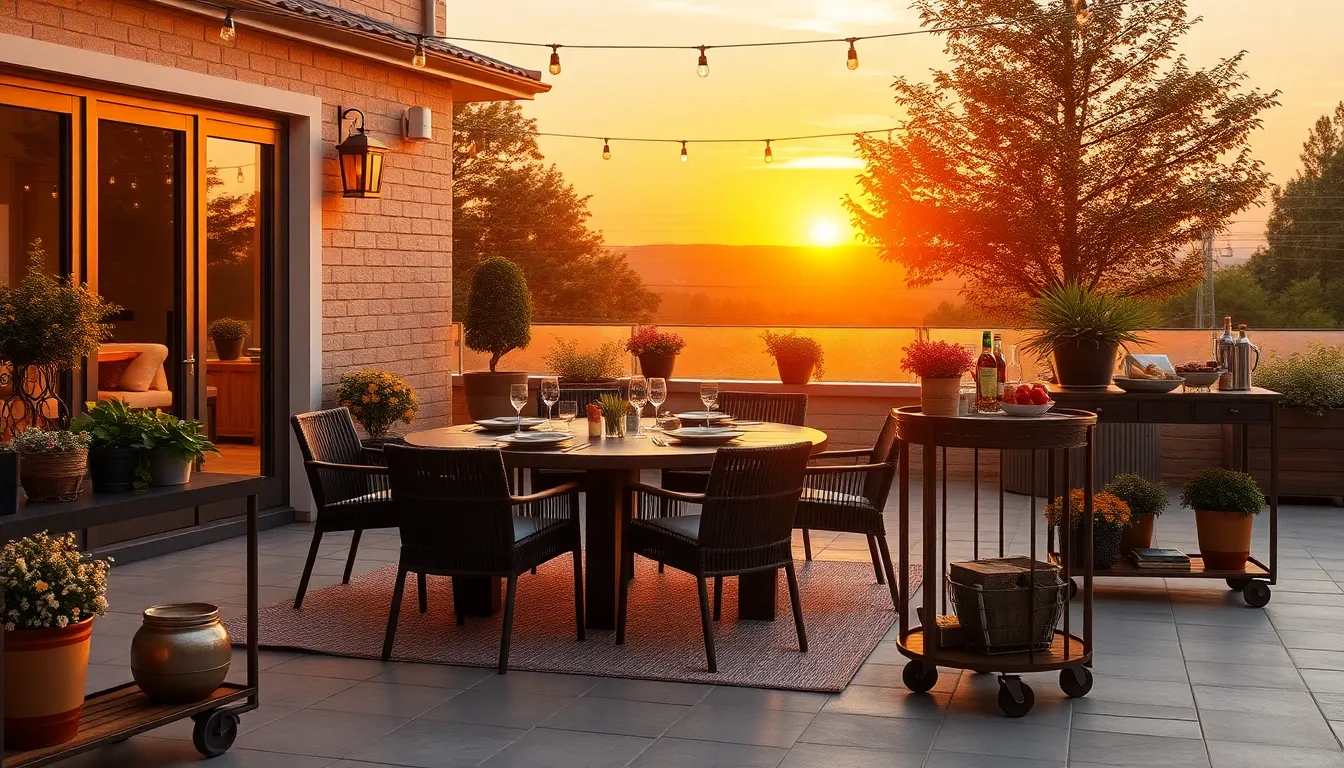
Creating a dedicated dining space elevates your patio from a simple outdoor area to an entertainment hub. We’ll transform your patio into the perfect setting for memorable meals and gatherings.
Choose an Appropriately Sized Dining Table
Select your dining table based on guest capacity and available patio space. Rectangular tables accommodate larger gatherings effectively, with their elongated shapes providing ample seating while maintaining smooth traffic flow around the perimeter. Oval tables offer similar benefits with softer edges that enhance movement patterns.
Round tables maximize smaller spaces efficiently. Their circular design eliminates sharp corners, promoting seamless navigation around the dining area. We recommend round tables for intimate gatherings of 4-6 people where conversation flows naturally across the table.
Bistro sets deliver space-saving answers for compact patios. Bar height tables paired with stools create cozy dining experiences while occupying minimal square footage. These elevated arrangements also provide better sightlines across your outdoor space.
Arrange Chairs for Easy Movement and Access
Position chairs to allow comfortable pullout space without obstruction. Guests need adequate room to slide chairs back and stand up naturally during meals. We suggest maintaining this clearance consistently around the entire table perimeter.
Maintain 2 to 4 feet of clearance on all sides of your dining table. This spacing ensures smooth traffic flow for both seated guests and those moving around the patio. Adequate clearance prevents bottlenecks during busy entertaining moments.
Keep all chairs positioned on outdoor rugs even when pulled out. This arrangement maintains visual cohesion while anchoring the entire dining zone. We recommend measuring your rug to accommodate fully extended chairs before finalizing placement.
Add a Serving Cart or Buffet Station
Incorporate a serving cart within easy reach of your dining table. Rolling carts provide flexible surface space for serving dishes and refreshments without crowding the main table. We position these stations 3-4 feet from the table for optimal accessibility.
Install a dedicated buffet station for larger entertaining events. Fixed buffet areas keep food and drinks organized while maintaining an uncluttered dining surface. These stations work particularly well along patio walls or near outdoor kitchen areas.
Enhance convenience by stocking serving stations with essential entertaining items. Include serving utensils, napkins, and beverages to minimize trips indoors during meals. We recommend weather-resistant storage answers to protect items between uses.
Establish Separate Activity Areas Using Furniture Zones
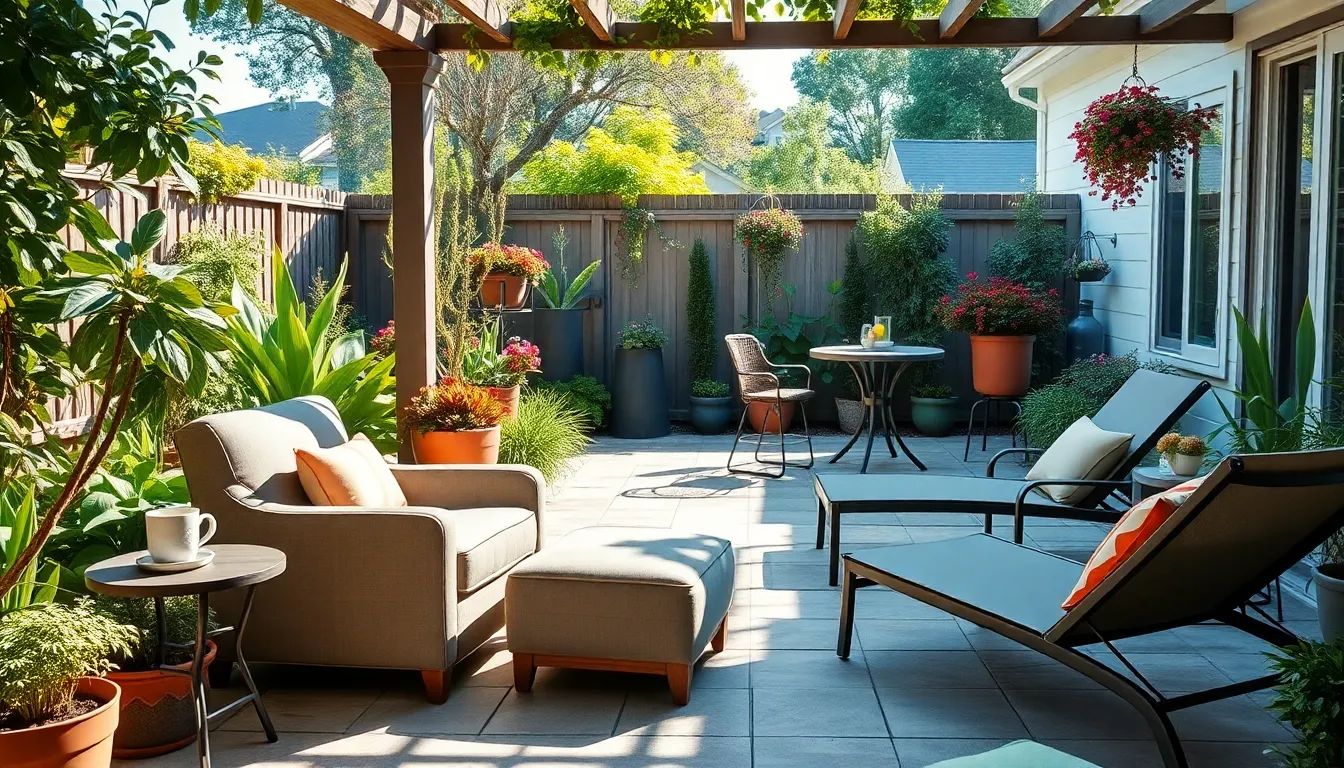
We’ll transform your patio into a multi-functional outdoor haven by creating distinct zones that cater to different activities and moods. Strategic furniture placement allows you to maximize every square foot while ensuring each area serves its unique purpose.
Create a Reading Nook with a Single Chair and Ottoman
Position a comfortable chair with an ottoman in a quiet corner of your patio to establish an intimate reading retreat. We recommend choosing a spot that naturally feels secluded from the main traffic flow, allowing you to escape into your favorite book without distractions. Add a small side table within arm’s reach to hold your coffee, reading glasses, or current page turner.
Consider shade options like a market umbrella or pergola overhead to protect yourself from harsh sunlight during those long reading sessions. Plant screens or tall planters can provide additional privacy and create a more enclosed feeling around your reading zone. This setup works particularly well when positioned to take advantage of natural light while maintaining comfort throughout different times of day.
Set Up a Game Area with Bistro Table and Stools
Bistro tables paired with stools create the perfect game zone that adapts beautifully to smaller patio spaces without sacrificing functionality. We suggest positioning this area with adequate lighting for evening card games or board game sessions, ensuring players can see clearly without straining their eyes. The compact footprint of bistro sets makes them ideal for patios where space is at a premium.
Maintain accessible pathways around your game area to keep the space inviting and practical for movement. Consider adding storage answers nearby, such as a weatherproof ottoman or deck box, to keep games and accessories organized and readily available. This zone works exceptionally well when placed adjacent to your main seating area, allowing spectators to easily join in the fun.
Design a Sunbathing Space with Lounge Chairs
Arrange lounge chairs in the sunniest part of your patio with adequate spacing between them to ensure comfortable movement and personal space. We recommend allowing at least 3 to 4 feet between chairs so you can walk around them easily and adjust positions throughout the day as the sun moves. Select adjustable loungers that let you find the perfect angle for maximum comfort during your outdoor relaxation time.
Position small side tables within reach of each lounge chair to hold sunscreen, beverages, books, or electronic devices. Ensure your sunbathing zone maintains clear sight lines to shade options like umbrellas or covered areas, allowing for quick refuge when the sun becomes too intense. This layout should complement your patio’s overall flow while creating a dedicated space for soaking up those beneficial rays.
Maximize Small Patio Spaces with Multi-Functional Furniture
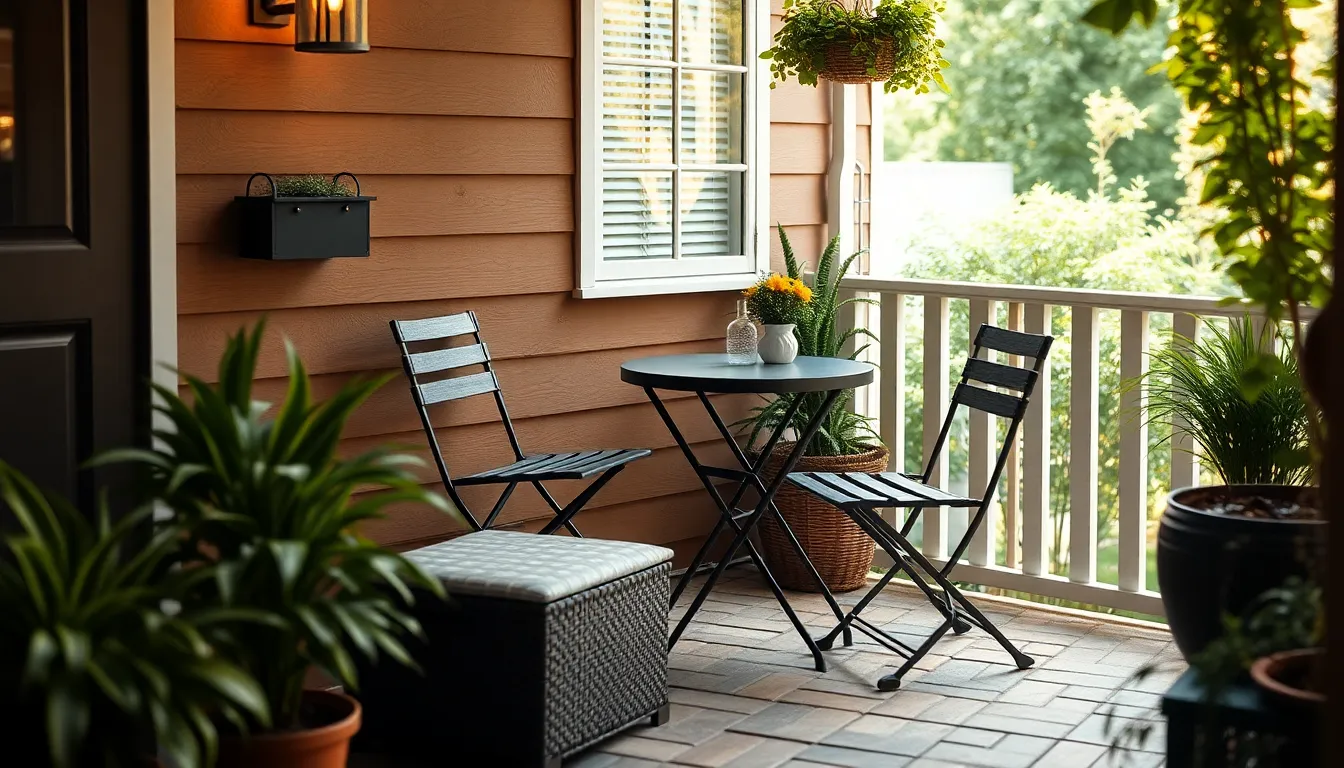
Small patio spaces require smart furniture choices that work harder for every square foot. We’ll show you how multi-functional pieces transform cramped outdoor areas into versatile living spaces.
Use Folding Tables and Stackable Chairs
Folding tables offer the ultimate space-saving solution for small patios where flexibility matters most. We recommend lightweight aluminum or weather-resistant materials that fold flat against walls or store in compact spaces when not needed. Tables with adjustable heights provide extra versatility for dining, working, or entertaining different group sizes.
Stackable chairs complement folding tables perfectly by disappearing into neat piles during storage. These chairs typically stack 4 to 6 high without compromising stability or comfort. We suggest choosing designs with integrated armrests and breathable materials like mesh or slatted wood that dry quickly after rain.
Nesting tables create additional surface area without permanent commitment to floor space. These sets typically include 2 to 3 tables that slide underneath each other when not in use. We position the largest table as our primary surface and pull out smaller ones for drinks, books, or decorative items.
Incorporate Storage Ottomans and Benches
Storage ottomans serve triple duty as seating, footrests, and hidden storage containers for outdoor essentials. We choose weather-resistant versions with lift-up tops that accommodate cushions, throws, gardening tools, and outdoor games. Ottomans with removable tops also function as side tables when topped with serving trays.
Built-in storage benches maximize seating capacity while eliminating clutter from small patio surfaces. These pieces typically offer 2 to 3 feet of seating length with storage compartments underneath. We recommend benches with gas-lift hinges for easy access and soft-close mechanisms that prevent slamming.
Corner storage benches use often-wasted angular spaces effectively in small patio layouts. These L-shaped pieces fit snugly into corners while providing ample storage and seating for 2 to 4 people. We position them against walls or railings to create defined zones without blocking traffic flow.
Choose Compact Bistro Sets for Intimate Dining
Compact bistro sets occupy minimal floor space while creating dedicated dining areas in small patios. These sets typically include tables measuring 24 to 30 inches in diameter paired with 2 chairs that tuck completely underneath. We recommend sets with slim profiles and vertical designs that emphasize height rather than width.
Bistro tables with pedestal bases offer superior leg room compared to four-legged alternatives in tight spaces. The single central support allows chairs to slide in from any angle and accommodates different seating positions. We choose adjustable-height pedestals that adapt to various chair styles and user preferences.
Folding bistro chairs with compact frames store easily when entertaining requires more open space. These chairs typically fold to 4 to 6 inches thick and hang on wall hooks or slide into narrow storage gaps. We select chairs with comfortable backs and supportive seats that don’t sacrifice comfort for space-saving design.
Incorporate Natural Traffic Flow Patterns
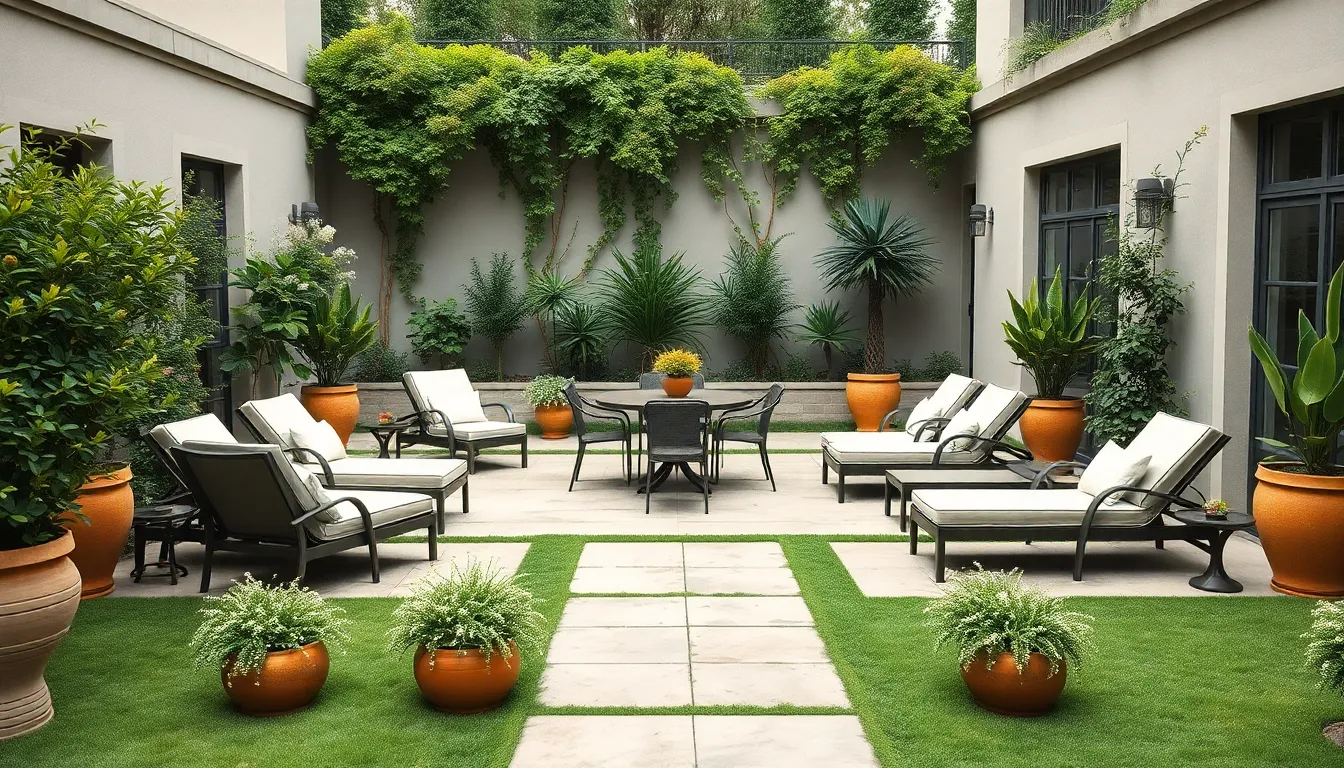
We need to consider how people naturally move through our patio space to create a layout that feels comfortable and intuitive. Smart traffic flow planning ensures our guests can navigate between furniture zones without feeling cramped or confused.
Leave Clear Pathways Between Furniture Groups
Maintaining 30 to 48 inches of space for high-traffic pathways creates smooth movement throughout our patio. We should cluster furniture into functional zones while keeping defined boundaries and open walkways between each area. Dining zones need clear separation from lounging areas so guests can access both spaces without disrupting others.
Obstructed paths make our patio feel cramped and create safety hazards for visitors. We’ll want to test our layout by walking through it ourselves before finalizing furniture placement. Areas with less frequent use can accommodate narrower 24-inch paths while still maintaining accessibility.
Creating visual buffers like planters or low dividers helps reinforce clear pathways without blocking movement. These elements guide foot traffic naturally while adding design appeal to our outdoor space.
Position Furniture Away from High-Traffic Areas
Primary seating works best when positioned so guests can walk around it rather than through it. We should identify the main circulation routes on our patio and keep these areas free from furniture obstacles. Grilling zones and serving areas typically generate the most foot traffic and need the widest clearance.
Anchoring large furniture pieces along walls or focal points prevents them from blocking natural movement patterns. We can use this strategy to create a more organized flow while maximizing our usable space. Corner placements work particularly well for bulky items like sectional seating or storage pieces.
Avoiding overcrowding in any single area helps maintain balance throughout our patio layout. We’ll distribute furniture evenly across the space rather than clustering everything in one zone.
Create Obvious Entry and Exit Points
Well-positioned furniture and intentional use of open space can highlight natural access points to our patio. We should arrange our layout so the main entrance feels welcoming and clearly defines where guests should enter. Multiple exit routes prevent bottlenecks during gatherings and improve overall safety.
Clearly marked access points help guests understand how to navigate our outdoor space without confusion. We can use furniture placement to frame doorways or create visual cues that guide movement patterns. Strategic lighting near entry points enhances visibility during evening entertainment.
Proportionate groupings support effective traffic patterns by creating natural stopping points throughout the patio. We’ll balance furniture density with open areas to maintain smooth circulation flow from entry to exit.
Balance Your Layout with Proper Scale and Proportion
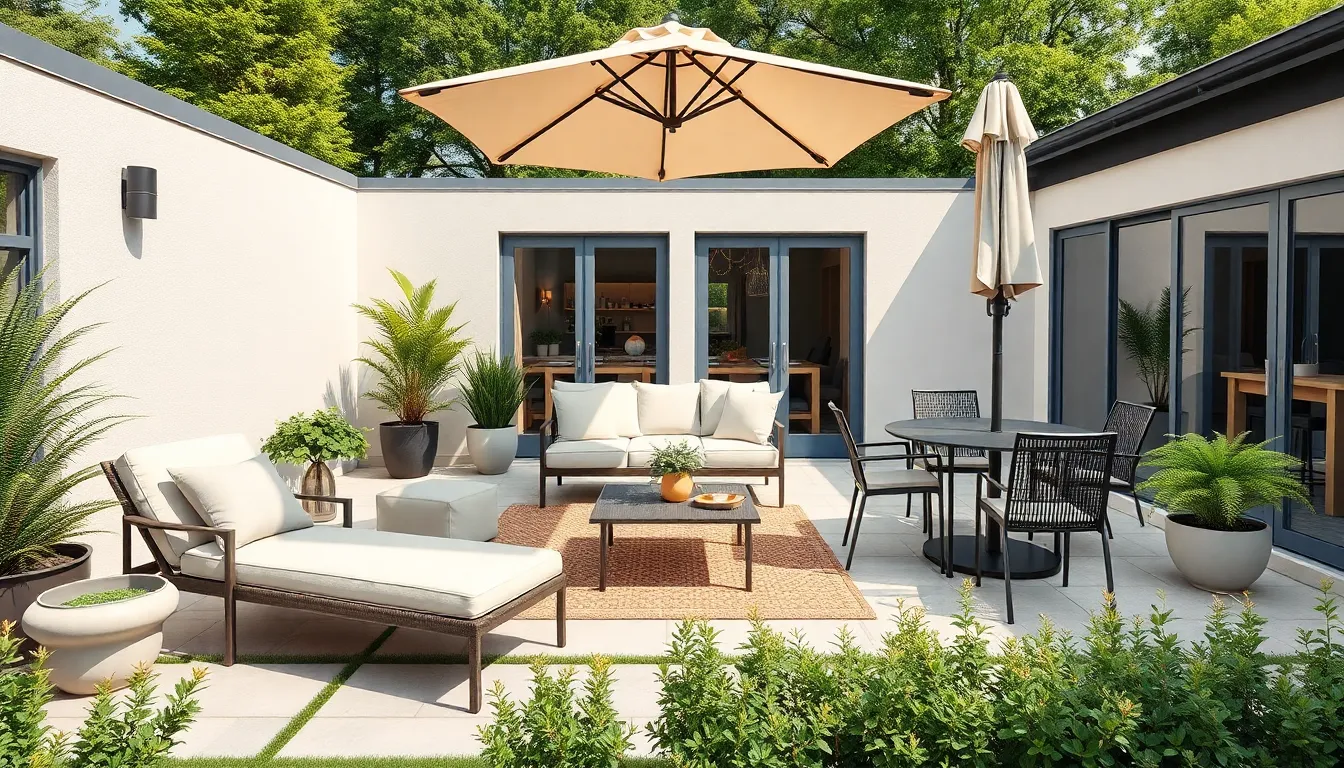
Now that we’ve established your distinct activity zones, let’s focus on creating visual harmony through proper scale and proportion. Getting these elements right transforms a collection of furniture into a cohesive outdoor living space.
Match Furniture Size to Patio Dimensions
Measuring your patio dimensions comes first before selecting any furniture pieces. We recommend sketching a rough layout that includes walkways and clearance areas around each piece to visualize the complete arrangement.
Choosing furniture proportionate to your space prevents the common mistakes of overcrowding or creating a sparse, unwelcoming atmosphere. Compact dining sets with benches work exceptionally well for smaller patios since they maximize seating without requiring the footprint of multiple individual chairs.
Larger patios allow for more expansive furniture layouts, but even these generous spaces need careful consideration. We’ve found that scattered placement makes even substantial patios feel disjointed rather than luxurious.
Vary Heights with Different Seating Options
Incorporating diverse seating heights adds visual interest and creates a more ever-changing outdoor environment. Mix sofas, lounge chairs, benches, and stools throughout your layout to achieve this layered effect.
Varying seat heights enhances the visual depth of your space, preventing that flat, monotonous appearance that plagues many patio arrangements. Low lounge chairs paired with standard height dining chairs create natural conversation zones while maintaining visual flow.
Using taller elements like umbrellas, pergolas, or fire features alongside lower seating establishes vertical balance across your entire patio. These height variations draw the eye upward and create focal points that anchor your overall design.
Maintain Visual Weight Distribution
Distributing furniture evenly prevents heavy clusters that make one area feel crowded while leaving other sections feeling abandoned. We always consider the visual weight of each piece when planning our arrangements.
Considering visual mass means recognizing that a bulky sectional sofa carries more visual weight than lightweight bistro chairs. Arrange these pieces so the visual mass feels balanced across your entire patio space.
Using symmetrical layouts creates a formal, ordered appearance that works well for traditional homes, while asymmetrical arrangements offer a relaxed, casual vibe perfect for contemporary settings. Both approaches require attention to visual weight distribution to succeed.
Ensuring clear pathways and functional zones supports both traffic flow and aesthetic balance throughout your outdoor living space.
Add Comfort and Style with Finishing Touches
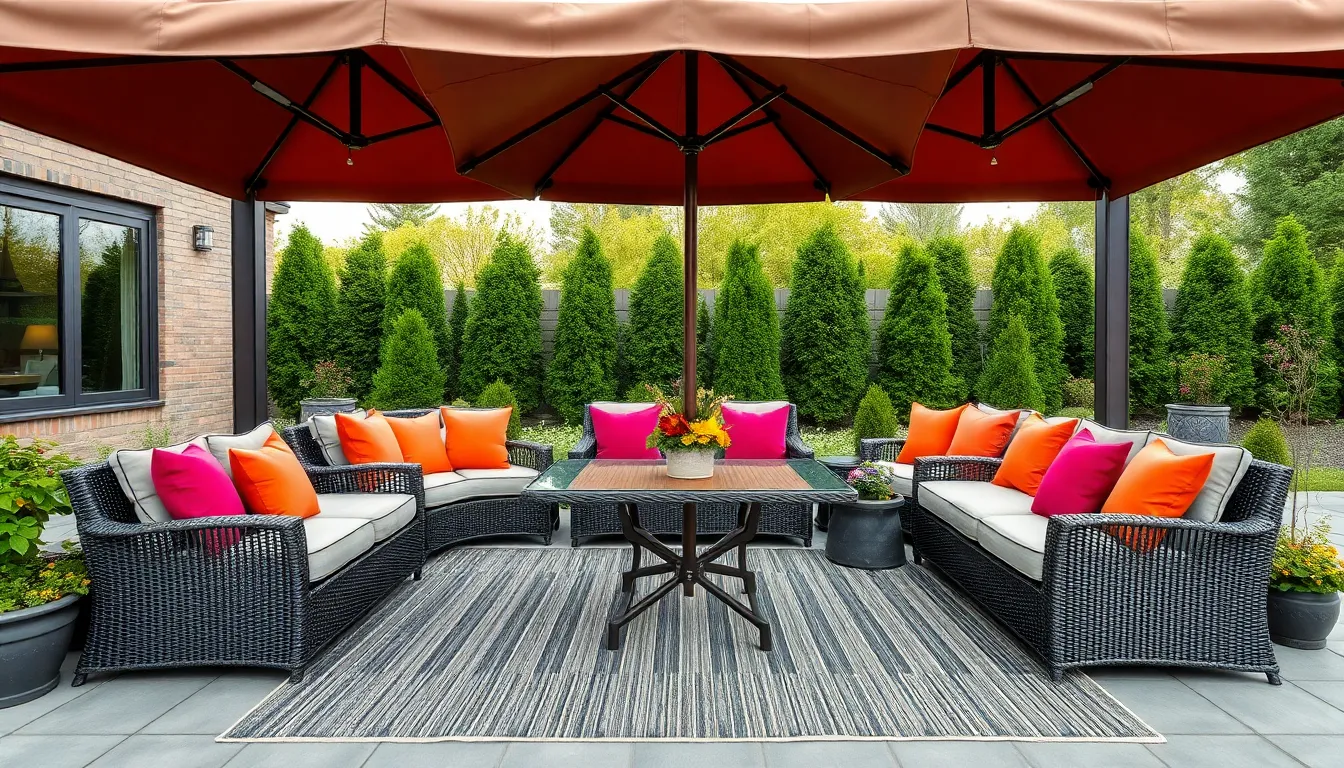
Perfect furniture placement sets the foundation, but it’s the finishing touches that transform our patio from functional to fabulous. We’ll show you how to layer comfort and style through strategic accessories.
Include Weather-Resistant Cushions and Pillows
Weather-resistant cushions and pillows serve as the ultimate comfort upgrade for our outdoor furniture. These essential accessories soften rigid seating surfaces while adding warmth and visual appeal to otherwise stark arrangements.
Since outdoor furniture faces constant exposure to sun, rain, and temperature fluctuations, we need cushions made from fade-proof and easy-to-clean materials. Look for fabrics specifically designed to withstand weather conditions without losing their color or shape over time.
Cushions create opportunities to introduce color and texture into our patio design. Mix different patterns and sizes to add visual interest while maintaining a cohesive color palette that complements our existing furniture. This layering approach extends our enjoyment of the outdoor space by making seating areas more inviting for longer periods.
Position Umbrellas or Shade Structures Strategically
Strategic shade placement makes the difference between a comfortable retreat and an unusable hot spot during peak sun hours. We should position umbrellas, awnings, pergolas, or canopies where our furniture receives the most direct sunlight.
Dining sets benefit most from overhead protection since meals often coincide with the sun’s strongest rays. Place umbrellas directly over dining tables or install awnings above seating areas near kitchen windows to create comfortable eating environments. This positioning prevents harsh sunlight from making outdoor dining uncomfortable or unsafe.
Lounge areas also require thoughtful shade consideration. Position shade structures to cover primary seating zones while allowing flexibility to move in and out of protected areas as desired. Consider adjustable umbrellas or retractable awnings for maximum versatility throughout different times of day.
Incorporate Outdoor Rugs to Define Spaces
Outdoor rugs serve as powerful tools for visually defining distinct zones within our patio layout. These accessories unify seating or dining areas by creating clear boundaries that help organize our outdoor space into purposeful sections.
Choose durable, water-resistant rugs specifically designed to withstand outdoor conditions. These materials resist fading, mold, and moisture damage while maintaining their appearance through multiple seasons. The right rug adds texture and softens hard flooring surfaces like concrete or stone.
Rugs anchor furniture arrangements cohesively by providing a visual foundation for our seating groups. Size the rug appropriately so all furniture legs sit comfortably on the surface, or ensure at least the front legs of chairs and sofas rest on the rug’s edge. This approach creates a polished, intentional look that elevates our entire patio design.
Consider Seasonal Flexibility in Your Arrangement
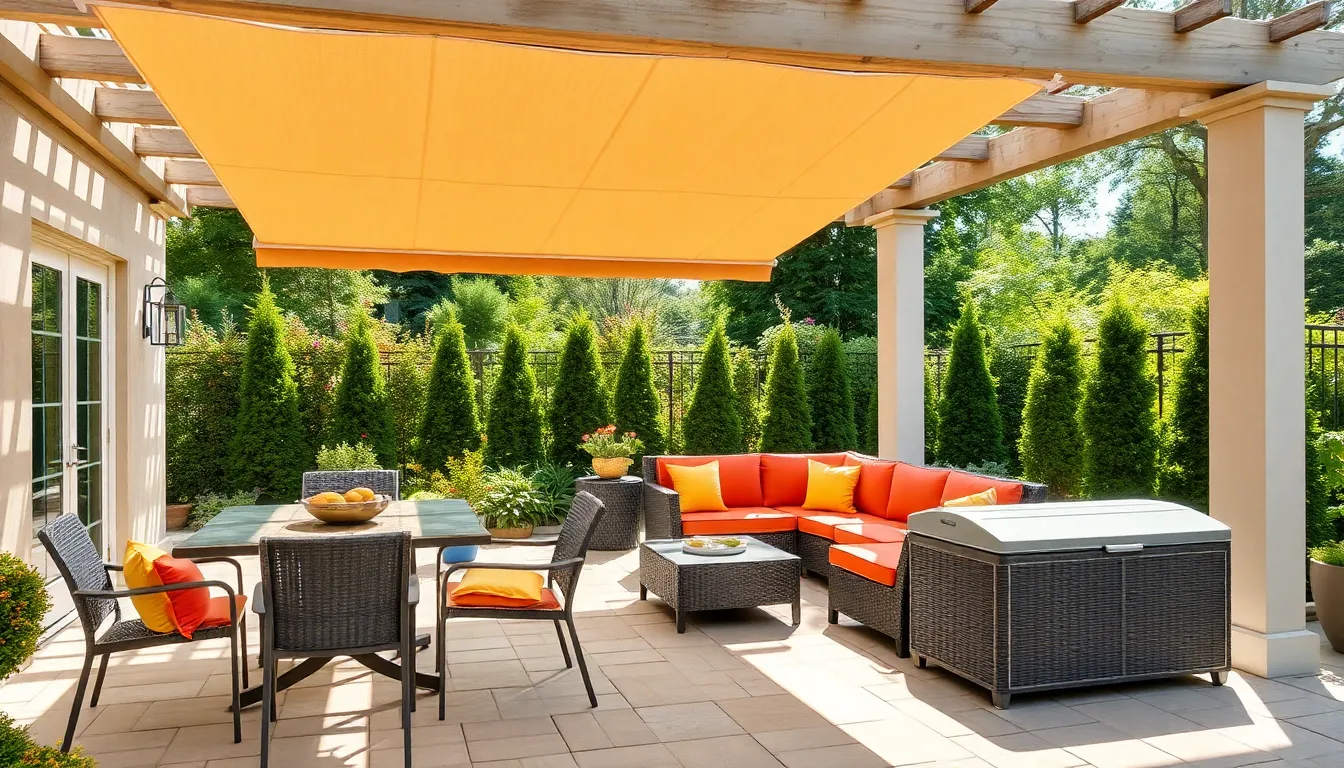
Smart patio furniture arrangements adapt to changing seasons and weather patterns throughout the year. We’ll help you create layouts that transform seamlessly from cozy fall gatherings to open summer entertaining spaces.
Plan for Easy Furniture Rearrangement
Choose lightweight or modular furniture pieces that move effortlessly when seasons change. Aluminum dining sets, resin wicker chairs, and modular sectionals allow us to reconfigure our outdoor space without straining our backs or requiring multiple people.
Avoid fixed or overly bulky pieces that lock us into permanent arrangements. Heavy concrete tables and built-in seating limit our ability to adapt the space for different activities throughout the year.
Measure your patio space carefully before purchasing furniture to ensure pieces fit comfortably with room for rearrangement. We recommend maintaining at least 36 inches of clearance around major furniture groups to allow smooth circulation during layout changes.
Group pieces strategically to create flexible zones that serve multiple purposes. Ottomans double as extra seating during parties and footrests during quiet evenings, while nesting tables expand surface area when needed and tuck away when space opens up.
Account for Sun and Shade Patterns Throughout the Day
Map out sunlight movement across your patio to identify the best spots for different activities at various times. Morning sun hits east-facing areas first, while afternoon heat concentrates on west and south-facing sections.
Position dining areas where natural shade falls during typical meal times to prevent overheating and sun glare on plates and glasses. We’ve found that locating dining sets near kitchen windows offers convenience but requires shade answers for safety and comfort.
Add flexible shade answers like umbrellas, awnings, pergolas, or canopies that adjust throughout the day. Market umbrellas with tilting mechanisms follow the sun’s path, while retractable awnings extend coverage during peak heat hours.
Create multiple seating options in both sunny and shaded areas to accommodate different preferences and times of day. Sun-loving guests gravitate toward open areas during cooler months, while shade seekers prefer covered spots during summer heat.
Prepare for Weather Protection and Storage
Select weatherproof materials that withstand sun, rain, wind, and temperature fluctuations without deteriorating. Teak, aluminum, and all-weather wicker maintain their appearance and function across seasons better than untreated wood or standard indoor materials.
Invest in protective covers specifically designed for your furniture shapes and sizes. Custom-fit covers protect dining sets, sectionals, and grills more effectively than generic tarps that allow moisture and debris to accumulate.
Plan storage answers for cushions, pillows, and seasonal accessories that need protection during harsh weather. Waterproof storage boxes, deck boxes, and indoor closet space keep soft furnishings dry and ready for the next season.
Choose water-resistant fabrics for cushions and umbrellas that dry quickly after rain and resist fading from UV exposure. Solution-dyed acrylic fabrics outperform cotton and polyester blends in outdoor conditions, maintaining color and texture longer.
Conclusion
Creating the perfect patio furniture layout doesn’t have to be overwhelming when you break it down into manageable steps. We’ve covered everything from establishing functional zones to maximizing small spaces with smart furniture choices.
Remember that your outdoor space should reflect your lifestyle and entertaining needs. Whether you’re hosting dinner parties or enjoying quiet morning coffee we encourage you to experiment with different arrangements until you find what works best.
The key to success lies in balancing functionality with visual appeal while maintaining clear pathways and comfortable proportions. With these proven strategies and a bit of creativity you’re well-equipped to transform your patio into the outdoor oasis you’ve always envisioned.
Frequently Asked Questions
How far apart should patio seating be arranged for comfortable conversation?
Position chairs and sofas 6 to 8 feet apart for optimal conversation flow. This distance allows guests to speak comfortably without shouting while maintaining an intimate atmosphere. U-shaped seating arrangements work best for fostering connection and ensuring everyone can participate in the conversation naturally.
What’s the ideal clearance space around a patio dining table?
Maintain 2 to 4 feet of clearance around your dining table to ensure smooth traffic flow and easy chair movement. This spacing allows guests to push back chairs without obstruction and creates comfortable pathways for serving food and moving around the dining area.
How wide should pathways be between patio furniture groups?
Leave clear pathways of 30 to 48 inches between furniture groups to facilitate comfortable movement and prevent overcrowding. This width accommodates multiple people walking simultaneously and ensures the space feels open and navigable, especially during gatherings or entertaining.
What size coffee table works best for outdoor seating arrangements?
Choose a coffee table that’s proportional to your seating arrangement and made from weather-resistant materials. The table should be easily accessible from all seating positions and serve as a functional anchor for the conversation area while coordinating with your overall patio style.
What are the best space-saving furniture options for small patios?
Folding tables, stackable chairs, nesting tables, and storage ottomans are ideal for small patios. These multi-functional pieces maximize space efficiency while providing necessary functionality. Compact bistro sets also work well for intimate dining without overwhelming limited square footage.
How do I create distinct activity zones on my patio?
Establish separate areas for different activities like dining, conversation, and relaxation by strategically grouping furniture. Use a dining table for entertainment, create a conversation nook with seating arrangements, add a reading corner with a comfortable chair, and designate a sunbathing area with lounge chairs.
What materials should I choose for outdoor furniture durability?
Select weather-resistant materials like aluminum, teak, or powder-coated steel that can withstand outdoor elements. Pair these with weatherproof cushions and protective covers. Consider lightweight options for furniture you’ll need to move or store seasonally while ensuring durability for year-round pieces.
How do I achieve visual balance in my patio furniture arrangement?
Vary seating heights to create visual interest and distribute visual weight evenly across the space. Measure your patio dimensions and sketch layouts to prevent overcrowding. Consider both symmetrical and asymmetrical arrangements, ensuring clear pathways and functional zones support both traffic flow and aesthetic appeal.

